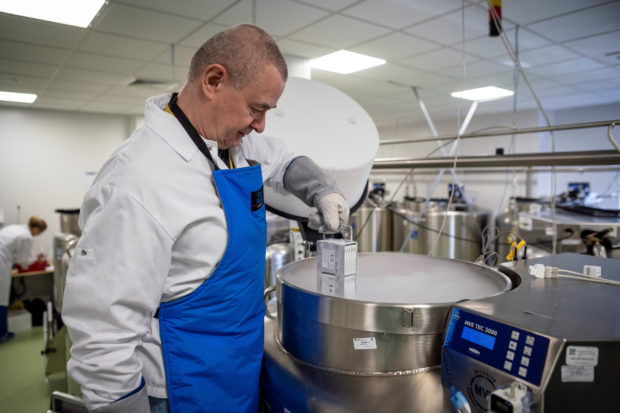Europe’s guardian of stem cells and hopes, real and unrealistic

Biologist Krzysztof Machaj shows stem cell samples, stored in large liquid nitrogen freezers, at the headquarters of the Polish umbilical cord blood bank PBKM/FamiCord. Image: AFP/Wojtek Radwanski
Poland has emerged as Europe’s leader in stem cell storage, a billion-dollar global industry that is a key part of a therapy that can treat leukemias but raises excessive hopes.
Submerged in liquid nitrogen vapor at a temperature of minus 175 degrees Celsius, hundreds of thousands of stem cells from all over Europe bide their time in large steel barrels on the outskirts of Warsaw.
Present in blood drawn from the umbilical cord of a newborn baby, stem cells can help cure serious blood-related illnesses like leukemias and lymphomas, as well as genetic conditions and immune system deficits.
Polish umbilical cord blood bank PBKM/FamiCord became the industry’s leader in Europe after Swiss firm Cryo-Save went bankrupt early last year.
It is also the fifth largest in the world, according to its management, after two companies in the United States, a Chinese firm and one based in Singapore.
Since the first cord blood transplant was performed in France in 1988, the sector has significantly progressed, fuelling hopes.
Health insurance
Mum-of-two Teresa Przeborowska has firsthand experience.
At five years old, her son Michal was diagnosed with lymphoblastic leukemia and needed a bone marrow transplant, the entrepreneur from northern Poland said.
The most compatible donor was his younger sister, Magdalena.
When she was born, her parents had a bag of her cord blood stored at PBKM.
More than three years later, doctors injected his sister’s stem cells into Michal’s bloodstream.
It was not quite enough for Michal’s needs but nicely supplemented harvested bone marrow.
As a result, Michal, who is nine, “is now flourishing, both intellectually and physically,” his mum told AFP.
A cord blood transplant has become an alternative to a bone marrow transplant when there is no donor available, with a lower risk of complications.
Stem cells taken from umbilical cord blood are like those taken from bone marrow, capable of producing all blood cells: red cells, platelets and immune system cells.
When used, stem cells are first concentrated, then injected into the patient. Once transfused, they produce new cells of every kind.
At the PBKM laboratory, “each container holds up to 10,000 blood bags… Safe and secure, they wait to be used in the future,” its head, Krzysztof Machaj, said.
The bank holds around 440,000 samples, not including those from Cryo-Save, he said.
If the need arises, the “blood will be ready to use without the whole process of looking for a compatible donor and running blood tests,” the biologist told AFP.
For families who have paid an initial nearly 600 euros (around P34,000) and then an annual 120 euros (around P7,000) to have the blood taken from their newborns’ umbilical cords preserved for around 20 years, it is a kind of health insurance promising faster and more effective treatment if illness strikes.
But researchers also warn against unrealistic expectations.
Beauty products
Hematologist Wieslaw Jedrzejczak, a bone marrow pioneer in Poland, describes promoters of the treatment as “sellers of hope,” who “make promises that are either impossible to realize in the near future or downright impossible to realize at all for biological reasons.”
He compares them to makers of beauty products who “swear their cream will rejuvenate the client by 20 years.”
Various research is being done on the possibility of using the stem cells to treat other diseases, notably nervous disorders. But the EuroStemCell scientist network warns that the research is not yet conclusive.
“There is a list of almost 80 diseases for which stem cells could prove beneficial,” U.S. hematologist Roger Mrowiec, who heads the clinical laboratory of the cord blood program Vitalant in New Jersey, told AFP.
“But given the present state of medicine, they are effective only for around a dozen of them, like leukemia or cerebral palsy,” he said.
“It’s not true, as it’s written sometimes, that we can already use them to fight Parkinson’s disease or Alzheimer’s disease or diabetes.”
EuroStemCell also cautions against private blood banks that “advertise services to parents suggesting they should pay to freeze their child’s cord blood… in case it’s needed later in life.”
“Studies show it is highly unlikely that the cord blood will ever be used for their child,” the network said.
It also pointed out that there could be a risk of the child’s cells not being useable anyway without reintroducing the same illness.
Some countries, such as Belgium and France, are cautious and ban the storage of cord blood for private purposes. Most E.U. countries however permit it while imposing strict controls.
Rapid growth
In the early 2000s, Swiss company Cryo-Save enjoyed rapid growth.
Greeks, Hungarians, Italians, Spaniards and Swiss stored blood from their newborns with the company for 20 years on payment of 2,500 euros (around P140,000) upfront.
When the firm was forced to close in early 2019, clients were left wondering where their stem cells would end up.
Under a kind of back-up agreement, the samples of some 250,000 European families were transferred for storage at PBKM.
The Polish firm, founded in 2002 with 2 million zlotys (around P26 million), has also grown quickly.
Present under the FamiCord brand in several countries, PBKM has some 35% of the European market, excluding Cryo-Save assets.
Over the last 15 months, outside investors have contributed 63 million euros to the firm, PBKM’s chief executive Jakub Baran told AFP.
But the company has not escaped controversy: the Polityka weekly recently published a critical investigative report on several private clinics that offer what was described as expensive treatment involving stem cells held by PBKM. IB/JB
RELATED STORIES:
2019: The year gene therapy came of age
Landmark trial finds stem cell treatment reduces disability for those with multiple sclerosis